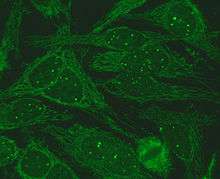Sp100 nuclear antigen
| SP100 nuclear antigen | |
|---|---|
| Identifiers | |
| Symbol | SP100 |
| Entrez | 6672 |
| HUGO | 11206 |
| OMIM | 604585 |
| RefSeq | NM_003113 |
| UniProt | P23497 |
| Other data | |
| Locus | Chr. 2 q37.1 |
Sp100 nuclear antigen is an interferon stimulated antigen found in the bile duct of primary biliary cirrhosis.[1] Histologically sp100 'dots' regions of the cell nucleus. Viral infection and mitogens affect the expression of the Sp100 autoantigen. Cells grown in the presence of interferons (α, β, and γ) revealed an increase both in size and number of the Sp100 protein-containing nuclear dots and increase the protein concentration. This raises "the question whether cytokine-mediated increase of Sp100 protein expression plays a role in induction of anti-Sp100 autoantibodies."[2]
Sp100 and nuclear dots

Two proteins, sp100 and promyelocytic leukemia (PML) factor are localized to punctate domains in the nucleus (nuclear dots or nuclear bodies). These domains (few to 20) were found to form a donut shaped structure when cells were starved of amino acids. In particular, depravation of cystine results in most pronounced changes.[3] Two other proteins, PIC1/SUMO-1, that also interact with nuclear pore complex factors also interact with these two proteins.[4] In addition sp100 interacts with a chromatin binding protein, HP1 alpha.[5]
Sp100 splicoforms
Some sp100 variants contain a domain similar to two interferon-inducible nuclear phosphoproteins, suppressin and DEAF1. This defines a novel protein motif, the HNPP-box. Another class of variants has high mobility group 1 (HMG1) protein sequence as a domain. Both major classes of Sp100 splice variant proteins localize in part to nuclear dots/PML bodies and other nuclear domains.[6]
References
- ↑ Szostecki C, Guldner HH, Netter HJ, Will H (1990). "Isolation and characterization of cDNA encoding a human nuclear antigen predominantly recognized by autoantibodies from patients with primary biliary cirrhosis". J. Immunol. 145 (12): 4338–47. PMID 2258622.
- ↑ Guldner HH, Szostecki C, Grötzinger T, Will H (1992). "IFN enhance expression of Sp100, an autoantigen in primary biliary cirrhosis". J. Immunol. 149 (12): 4067–73. PMID 1281200.
- ↑ Kamei H (1997). "Cystine starvation induces reversible large-body formation from nuclear bodies in T24 cells". Exp. Cell Res. 237 (1): 207–16. doi:10.1006/excr.1997.3790. PMID 9417884.
- ↑ Sternsdorf T, Jensen K, Will H (1997). "Evidence for covalent modification of the nuclear dot-associated proteins PML and Sp100 by PIC1/SUMO-1". J. Cell Biol. 139 (7): 1621–34. doi:10.1083/jcb.139.7.1621. PMC 2132645
 . PMID 9412458.
. PMID 9412458. - ↑ Seeler JS, Marchio A, Sitterlin D, Transy C, Dejean A (1998). "Interaction of SP100 with HP1 proteins: a link between the promyelocytic leukemia-associated nuclear bodies and the chromatin compartment". Proc. Natl. Acad. Sci. U.S.A. 95 (13): 7316–21. doi:10.1073/pnas.95.13.7316. PMC 22602
 . PMID 9636146.
. PMID 9636146. - ↑ Guldner HH, Szostecki C, Schröder P, et al. (1999). "Splice variants of the nuclear dot-associated Sp100 protein contain homologies to HMG-1 and a human nuclear phosphoprotein-box motif". J. Cell. Sci. 112. ( Pt 5): 733–47. PMID 9973607.